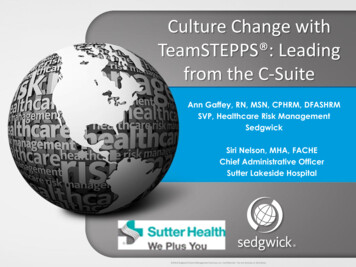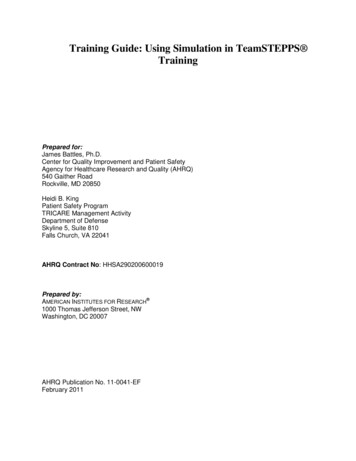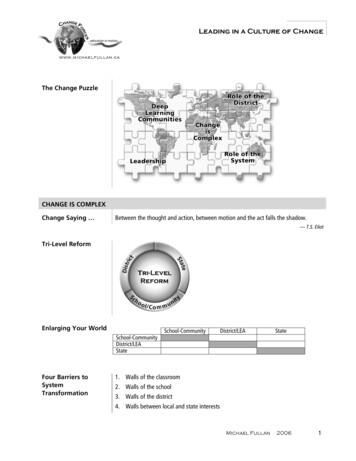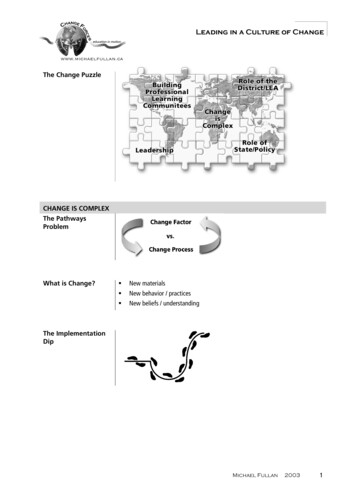
Transcription
Culture Change withTeamSTEPPS : Leadingfrom the C-SuiteAnn Gaffey, RN, MSN, CPHRM, DFASHRMSVP, Healthcare Risk ManagementSedgwickSiri Nelson, MHA, FACHEChief Administrative OfficerSutter Lakeside Hospital 2014 Sedgwick Claims Management Services, Inc. Confidential – Do not disclose or distribute.
Changing Culture Takes a Village!Culture exists in some organizations 98% by default andaccident, rather than by designSedgwick 2012 Confidential – Do not disclose or distribute.2
Drivers of Culture Change Patient SatisfactionStaff SatisfactionLawsuitsPublic opinionDesire for a climate of trust andteamworkSedgwick 2012 Confidential – Do not disclose or distribute.3
What the public sees:Sedgwick 2012 Confidential – Do not disclose or distribute.4
What the CFO sees:“The penalty is 50,000”Sedgwick 2012 Confidential – Do not disclose or distribute.5
What staff live with:Sedgwick 2012 Confidential – Do not disclose or distribute.6
Uncertainty is inconvenient!Sedgwick 2012 Confidential – Do not disclose or distribute.7
S trategies andT ools toE nhanceP erformance andP atientS afetyPerinatal InitiativeSedgwick 2012 Confidential – Do not disclose or distribute.8
Sedgwick 2012 Confidential – Do not disclose or distribute.9
Sedgwick 2012 Confidential – Do not disclose or distribute.10
Engaging in TeamSTEPPS Kotter’s 8 Steps of ChangeSedgwick 2012 Confidential – Do not disclose or distribute.11
Sedgwick 2012 Confidential – Do not disclose or distribute.12
-12Sedgwick 2012 Confidential – Do not disclose or distribute.1313
14Sedgwick 2012 Confidential – Do not disclose or distribute.14
Sedgwick 2012 Confidential – Do not disclose or distribute.15
Sedgwick 2012 Confidential – Do not disclose or distribute.16
Sutter Health PerinatalPatient Safety ProgramSedgwick 2012 Confidential – Do not disclose or distribute.17
Leading from the C-Suite:Without leadership there is no change!Sedgwick 2012 Confidential – Do not disclose or distribute.18
Quality Delivery System (Lean) Adoption In 2011 SLH began our journey to implement Lean as our operating system atthe hospital.We invested in the necessary culture changes :– 15 leaders attended Certification training (8 days of classes in Lean)– All leaders (30 ) attended an 8 hour training– Hired a full time QDS Specialist – a Med/Surg RN at SLH for 9 years– 4 service lines performing active improvement work Inpatient, Surgery , Emergency Services, Family Medicine Clinic – Ran numerous Kaizen workshops and eventsThe results were impressive:– Reduced staff walking time– Improved communication– Engaged frontline staff in developing and implementing the solutions– Created high visibility within the organizationSedgwick 2012 Confidential – Do not disclose or distribute.19
Toyota management systemHoshin kanriJust-in-timepeoplestandardworktakt stemequipmentandon &availabilitypull systemproductionleveled production (heijunka)cost reduction through the elimination of muda5SJidoka
But, it wasn’t enough While we continued to make improvements inthe open service lines, the changes were notbeing embedded in our culture Frontline staff were still fearful in raising safetyconcerns Accidents and errors still happenedSedgwick 2012 Confidential – Do not disclose or distribute.21
We still have a long way to go AHRQ Culture of Safety Survey results haddeclined year to year (Spring of ‘12 to Spring of ‘13) Experience of Work (EOW) employeeengagement / satisfaction survey resultsdeclined (Fall of ‘11 to Fall of ‘12) Provider satisfaction survey results had declined Root Cause Analysis (RCA) results indicated thatadverse events were directly tied to failures incommunicationSedgwick 2012 Confidential – Do not disclose or distribute.22
Motivation for Changing our CultureAHRQ survey results indicated that the overall perceptions of safety declinedfrom 58% positive to 53% positive Staff will freely speak up if they seesomething that may negatively affectpatient care. Staff feel free to question the decisionsor actions of those with more authority. Staff are afraid to ask questions whensomething does not seem right.Sedgwick 2012 Confidential – Do not disclose or distribute.23
Experience of Work Survey Results In 2012, only 60% of the respondents felt likethey have opportunities to have their ideasadopted and put into use – a decline of 1% from2011 In 2012, only 61% of the respondents felt thatthe organization was doing a good job ofmonitoring and improving the safety of theirwork area – a decline of 11% from 2011Sedgwick 2012 Confidential – Do not disclose or distribute.24
TeamSTEPPS Under the leadership of the Sutter Health System, SLHengaged the entire Family Birth Center team in learning TeamSTEPPS The staff and the providers were excited about the potentialto use this new set of tools to move our organization forward The FBC began having daily briefs, huddles and debriefs They used CUS to talk about safety concerns (I amconcerned I am uncomfortable This is a safety issue .) TeamSTEPPS fit hand and glove with QDS (Lean)–––––The absolute belief that zero errors is possibleJidoka – Stop the lineChallenge the status quo - 5X WhyHard on process / soft on peopleGenchi Gembutsu – Go and seeSedgwick 2012 Confidential – Do not disclose or distribute.25
Sedgwick 2012 Confidential – Do not disclose or distribute.26
Where we are now All staff (300 ) haveattended the 4hour introductionto TeamSTEPPS We haveTeamSTEPPSchampions fromacross theorganization Our QDS DailyManagementSystem hasembeddedTeamSTEPPS toolsSedgwick 2012 Confidential – Do not disclose or distribute.27
Where we are nowSedgwick 2012 Confidential – Do not disclose or distribute.28
Where are we now?Sedgwick 2012 Confidential – Do not disclose or distribute.29
Are we glad we did this? Implementing TeamSTEPPS across our entireorganization is helping us move to become atruly learning organization We are beginning our journey and still have along way to go We are fully committed to making SutterLakeside Hospital a highly reliable system whereeveryone is committed to ensuring a safe placefor providing careSedgwick 2012 Confidential – Do not disclose or distribute.30
2013 Experience of Work Survey Results In 2012, only 60% of the respondents felt likethey have opportunities to have their ideasadopted and put into use – in 2013 thisimproved to 65% of the respondents In 2012, only 61% of the respondents felt thatthe organization was doing a good job ofmonitoring and improving the safety of theirwork area – in 2013 this result improved to 74%of the respondentsSedgwick 2012 Confidential – Do not disclose or distribute.31
Questions?Sedgwick 2013 Confidential – Do not disclose or distribute.
Culture Change with TeamSTEPPS : Leading from the C-Sui










